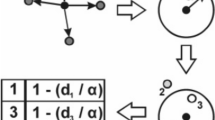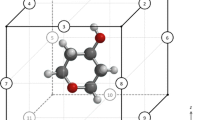Abstract
A data set containing 686 Src kinase inhibitors and 1,941 Src kinase non-binding decoys was collected and used to build two classification models to distinguish inhibitors from decoys. The data set was randomly split into a training set (458 inhibitors and 972 decoys) and a test set (228 inhibitors and 969 decoys). Each molecule was represented by five global molecular descriptors and 18 2D property autocorrelation descriptors calculated using the program ADRIANA.Code. Two machine learning methods, a Kohonen’s self-organizing map (SOM) and a support vector machine (SVM), were utilized for the training and classification. For the test set, classification accuracy (ACC) of 99.92% and Matthews correlation coefficient (MCC) of 0.98 were achieved for the SOM model; ACC of 99.33% and MCC of 0.98 were obtained for the SVM model. Some molecular properties, such as molecular weight, number of atoms in a molecule, hydrogen bond properties, polarizabilities, electronegativities, and hydrophobicities, were found to be important for the inhibition of Src kinase.
Similar content being viewed by others
References
Jr RR (2004) Src protein–tyrosine kinase structure and regulation. Biochem Biophys Res Comm 324: 1155–1164. doi:10.1016/j.bbrc.2004.09.171
Robinson DR, Wu Y, Lin S (2000) The protein tyrosine kinase family of the human genome. Oncogene 19: 5548–5557. doi:10.1038/sj.onc.1203957
Zhang N, Wua B, Boschelli DH, Golas JM, Boschelli F (2009) 4-Anilino-7-pyridyl-3-quinolinecarbonitriles as Src kinase inhibitors. Bioorg Med Chem Lett 19: 5071–5074. doi:10.1016/j.bmcl.2009.07.043
Liu T, Lin Y, Wen X, Jorissen RN, Gilson MK (2007) BindingDB: a web-accessible database of experimentally determined protein–ligand binding affinities. Nucl Acids Res 35: D198–D201. doi:10.1093/nar/gkl999
Wang Y, Metcalf CA, Shakespeare W, Sundaramoorthi R, Keenan TP, Bohacek RS, Schravendijk MR, Violette SM, Narula SS, Dalgarno DC, Haraldson C, Keats J, Liou S, Mani U, Pradeepan S, Ram M, Adams S, Weigele M, Sawyer TK (2003) Bone-Targeted 2,6,9-Trisubstituted purines: novel inhibitors of Src tyrosine kinase for the treatment of bone diseases. Bioorg Med Chem Lett 13: 3067–3070. doi:10.1016/S0960-894X(03)00648-6
Blake RA, Broome MA, Liu X, Wu J, Gishizky M, Sun L, Courtneidge SA (2000) SU6656, a selective Src family kinase inhibitor, used to probe growth factor signaling. Mol Cell Biol 20: 9018–9027. doi:10.1128/MCB.20.23.9018-9027.2000
Ple PA, Green TP, Hennequin LF, Curwen J, Fennell M, Allen J, Vander Brempt CL, Costello G (2004) Discovery of a new class of anilinoquinazoline inhibitors with high affinity and specificity for the tyrosine kinase domain of c-Src. J Med Chem 47: 871–887. doi:10.1021/jm030317k
Missbach M, Jeschke M, Feyen J, Muller K, Glatt M, Green J, Susa M (1999) A novel inhibitor of the tyrosine kinase Src suppresses phosphorylation of its major cellular substrates and reduces bone resorption in vitro and in rodent models in vivo. Bone 24: 437–449. doi:10.1016/S8756-3282(99)00020-4
Kraker AJ, Hartl BG, Amar AM, Barvian MR, Showalter HDH, Moore CW (2000) Biochemical and cellular effects of c-Src kinase-selective pyrido[2,3-d]pyrimidine tyrosine kinase inhibitors. Biochem Pharmacol 60: 885–898. doi:10.1016/S0006-2952(00)00405-6
Boschelli DH, Powell D, Golas JM, Boschelli F (2003) Inhibition of Src kinase activity by 4-anilino-5,10-dihydropyrimido[4,5-b]-quinolines. Bioorg Med Chem Lett 13: 2977–2980. doi:10.1016/S0960-894X(03)00628-0
Saad F, Lipton A (2010) SRC kinase inhibition: targeting bone metastases and tumor growth in prostate and breast cancer. Cancer Treat Rev 36: 177–184. doi:10.1016/j.ctrv.2009.11.005
Zhu J, Lu W, Liu L, Gu T, Niu B (2009) Classification of Src kinase inhibitors based on support vector machine. QSAR Comb Sci 28: 719–727. doi:10.1002/qsar.200860105
Tintori C, Magnani M, Schenone S, Botta M (2009) Docking, 3D-QSAR studies and in silico ADME prediction on c-Src tyrosine kinase inhibitors. Eur J Med Chem 44: 990–1000. doi:10.1016/j.ejmech.2008.07.002
Vidal M, Gigoux V, Garbay C (2001) SH2 and SH3 domains as targets for anti-proliferative agents. Crit Rev Oncol Hematol 40: 175–186. doi:10.1016/S1040-8428(01)00142-1
Altmann E, Missbach M, Green J, Susa M, Wagenknecht H, Widler L (2001) 7-Pyrrolidinyl- and 7-Piperidinyl-5-aryl-pyrrolo[2,3-d]-pyrimidines—potent inhibitors of the tyrosine kinase c-Src. Bioorg Med Chem Lett 11: 853–856. doi:10.1016/S0960-894X(01)00080-4
Boschelli DH, Wang YD, Johnson S, Wu B, Ye F, Sosa ACB, Golas JM, Boschelli F (2004) 7-Alkoxy-4-phenylamino-3-quinolinecar-bonitriles as dual inhibitors of Src and Abl kinases. J Med Chem 47: 1599–1601. doi:10.1021/jm0499458
Guan H, Laird AD, Blake RA, Tanga C, Liang C (2004) Design and synthesis of aminopropyl tetrahydroindole-based indolin-2-ones as selective and potent inhibitors of Src and Yes tyrosine kinase. Bioorg Med Chem Lett 14: 187–190. doi:10.1016/j.bmcl.2003.09.069
Boschelli DH, Sosa ACB, Golas JM, Boschelli F (2007) Inhibition of Src kinase activity by 7-ethynyl-4-phenylamino-3-quinolinecarbonitriles: identification of SKS-927. Bioorg Med Chem Lett 17: 1358–1361. doi:10.1016/j.bmcl.2006.11.077
Boschelli DH, Wang D, Wang Y, Wu B, Honores EE, Sosa ACB, Chaudhary I, Golas J, Lucas J, Boschelli F (2010) Optimization of 7-alkene-3-quinolinecarbonitriles as Src kinase inhibitors. Bioorg Med Chem Lett 20: 2924–2927. doi:10.1016/j.bmcl.2010.03.025
Huang N, Shoichet BK, Irwin JJ (2006) Benchmarking sets for molecular docking. J Med Chem 49: 6789–6801. doi:10.1021/jm0608356
ADRIANA.Code. Molecular Networks GmbH, Erlangen. http://www.molecular-networks.com/. Accessed April 2012
Gasteiger J (2006) Of molecules and humans. J Med Chem 49: 6429–6434. doi:10.1021/jm0608964
Wagener M, Sadowski J, Gasteiger J (1995) Autocorrelation of Molecular surface properties for modeling corticosteroid binding globulin and cytosolic Ah receptor activity by neural networks. J Am Chem Soc 117: 7769–7775. doi:10.1021/ja00134a023
Bouckaert RR, Frank E, Hall MA, Holmes G, Pfahringer B, Reutemann P, Witten IH (2010) WEKA-experiences with a Java open-source project. J Mach Learn Res 11: 2533–2541
Vapnik V, Chapelle O (2000) Bounds on error expectation for support vector machines. Neural Comput 12: 2013–2036. doi:10.1162/089976600300015042
Kohonen T (1982) Self-organized formation of topologically correct feature maps. Biol Cybern 43: 59–69. doi:10.1007/BF00337288
Zupan J, Gasteiger J (1999) Neural networks in chemistry and drug design, 2nd ed. Wiley: Weinheim
SONNIA, version 4.2. Molecular Networks GmbH, Erlangen. http://www.molecular-networks.com. Accessed April 2012
Boser BE, Guyon I, Vapnik V (1992) A training algorithm for optimal margin classifiers. In: Haussler D (ed) Fifth annual workshop on computational learning theory. ACM, New York, pp 144–152
Cortes C, Vapnik V (1995) Support-vector networks. Mach Learn 20: 273–297. doi:10.1007/BF00994018
Burges CJC (1998) A tutorial on support vector machines for pattern recognition. Data Min Knowl Disc 2: 121–167. doi:10.1023/A:1009715923555
Chang CC, Lin CJ (2011) LIBSVM: a library for support vector machine. http://www.csie.ntu.edu.tw/~cjlin/libsvm. Accessed April 2012
MOE (The Molecular Operating Environment), version 2009.2010. Chemical Computing Group Inc., Montreal
Kryger G, Harel M, Giles K, Toker L, Velan B, Lazar A, Kronman C, Barak D, Ariel N, Shafferman A, Silman I, Sussman JL (2000) Structures of recombinant native and E202Q mutant human acetylcholinesterase c omplexed with the snake-venom toxin fasciculin-II. Acta Crystallogr D 56: 1385–1394. doi:10.1107/S0907444900010659
Matthews BW (1975) Comparison of the predicted and observed secondary structure of T4 phage lysozyme. Biochim Biophys Acta 405: 442–451
Hennequin LF, Allen J, Breed J, Curwen J, Fennell M, Green TP, Brempt CL, Morgentin R, Norman RA, Olivier A, Otterbein L, Plé PA, Warin N, Costello G (2006) N-(5-Chloro-1,3-benzodioxol −4-yl)-7-[2- (4-methylpiperazin-1-yl) ethoxy] - 5-(tetrahydro-2H-pyran-4-yloxy)quinazolin-4-amine, a Novel, Highly Selective, Orally Available, Dual-Specific c-Src/Abl Kinase Inhibitor. J Med Chem 49: 6465–6488. doi:10.1021/jm060434q
Noronha G, Barrett K, Cao J, Dneprovskaia E, Fine R, Gong X, Gritzen C, Hood J, Kang X, Klebansky B, Li G, Liao W, Lohse D, Mak CC, McPherson A, Palanki MSS, Pathak VP, Renick J, Soll R, Splittgerber U, Wrasidlo W, Zeng B, Zhao N, Zhou Y (2006) Discovery and preliminary structure–activity relationship studies of novel benzotriazine based compounds as Src inhibitors. Bioorg Med Chem Lett 16: 5546–5550. doi:10.1016/j.bmcl.2006.08.035
Sun M, Zheng Y, Wei H, Chen J, Cai J, Ji M (2009) Enhanced replacement method-based quantitative structure–activity relationship modeling and support vector machine classification of 4-anilino-3-quinolinecarbonitriles as Src kinase inhibitors. QSAR Comb Sci 28: 312–324. doi:10.1002/qsar.200860107
Author information
Authors and Affiliations
Corresponding author
Electronic Supplementary Material
The Below is the Electronic Supplementary Material.
Rights and permissions
About this article
Cite this article
Yan, A., Hu, X., Wang, K. et al. Discriminating of ATP competitive Src kinase inhibitors and decoys using self-organizing map and support vector machine. Mol Divers 17, 75–83 (2013). https://doi.org/10.1007/s11030-012-9411-0
Received:
Accepted:
Published:
Issue Date:
DOI: https://doi.org/10.1007/s11030-012-9411-0




